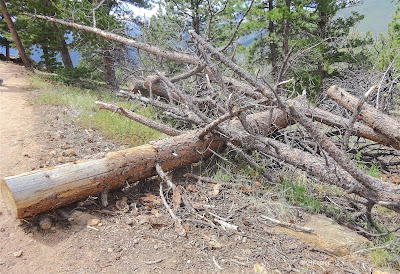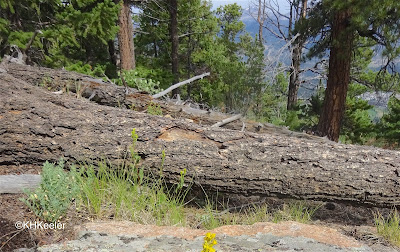Walking in Rocky Mountain National Park, there are many places where fallen trees lie. It looks messy.
The visitor might think: they should clean that up, but perhaps they don't have the budget, or the spot is inaccessible.
It is more complex than that. Leaving fallen trees lie may be the best use for them.
If you remove fallen trees from the national park, where would they go? A huge storage lot? A bonfire?
Particularly large numbers of fallen trees are the result of pine and spruce bark beetles, which had an outbreak that swept through the Rocky Mountains between about 2000 and 2012. They left lots of dead trees.
 |
| Standing dead trees, a photo from 2016 |
Our global warming is caused by build up of compounds in the air, especially carbon dioxide, which trap heat normally lost into space (more info). Plants capture carbon from the atmosphere and build it into their tissues. Wood, for example, is about 50% carbon. If you burn it, most of the carbon will go back into the atmosphere as carbon dioxide (link). Burning dead wood is, in a global warming sense, the opposite of planting trees.
 |
| young trees growing among the fallen ones, getting nutrients from the fallen |
Of course dead trees decay, releasing carbon dioxide. But that can take decades. While decaying, the wood may be consumed by animals or fungi and so its carbon will cycle through living things, delaying release into the atmosphere. Some trees will be buried before decaying, so their carbon will linger in the ground.
Beyond carbon, the dead trees, decaying, provide nutrients for other plants. Ecologists have long asked for standing dead trees, snags, to be left because all sorts of animals live in them, from owls to raccoons to, if it is big enough, bears. Fallen trees provide many of those services. Not all the protection from fallen trees is for animals; in the photo below, the flowers are clustered near and under the branches of the fallen tree because browsing animals, elk and deer mainly, found those hard to reach and browsed elsewhere.
 |
| Flowers are more dense under the old branches because the old brances protected the plants from grazing by elk and deer |
But what of wildfires? As I write this, there are big fires in the forests of Colorado. Don't fallen trees facilitate wildfires? All that fallen stuff burns, and that, like any fire, adds carbon dioxide and other compounds to the atmosphere. But whether fallen trees make fires worse depends on the conditions. Fallen trees used to be live trees. The pines and spruces burn very easily when alive, especially if it is dry or very dry. So there is no more fuel in the mountains than there was when the trees were alive and, in fact, when the pine and spruce needles have fallen, it is harder to ignite a tree. On the other hand, the logs on the forest floor, though they do not catch fire easily, will burn hot and for a long time, likely doing more damage to organisms in the soil than had the burned standing.
Fast or slow fires, burning living or dead trees, wildfires send tons of previously inert carbon up into the atmosphere. At the same time, fires are a natural part of the Rocky Mountain forest ecosystem. Most animals and plants are adapted to fire, the animals moving away from smoke or into deep burrows, the plants dying back only to soil level or actually benefitting from it, as their seeds are stimulated by fire and germinate in fire-cleared ground (fire released seeds, other fire-adaptations examples). Generally the forest recovers quickly--in forest-years, a decade being a small part of the life of a pine that lives to be 350 years old.
When you see the fallen trees of the Rockies, think of them as den sites and recycling centers, not trash. In fact, look closely for burrow holes in and under them.
Comments and corrections welcome.
Kathy Keeler, A Wandering BotanistMore at awanderingbotanist.com
Join me on Facebook: https://www.facebook.com/AWanderingBotanist




Very interesting post. I did not know how flammable live spruce and pine are. Thanks. (from Hollis in smoky Laramie)
ReplyDelete